Shared Bedroom for Kids: 27 Clever Ways to Design, Divide, and Delight
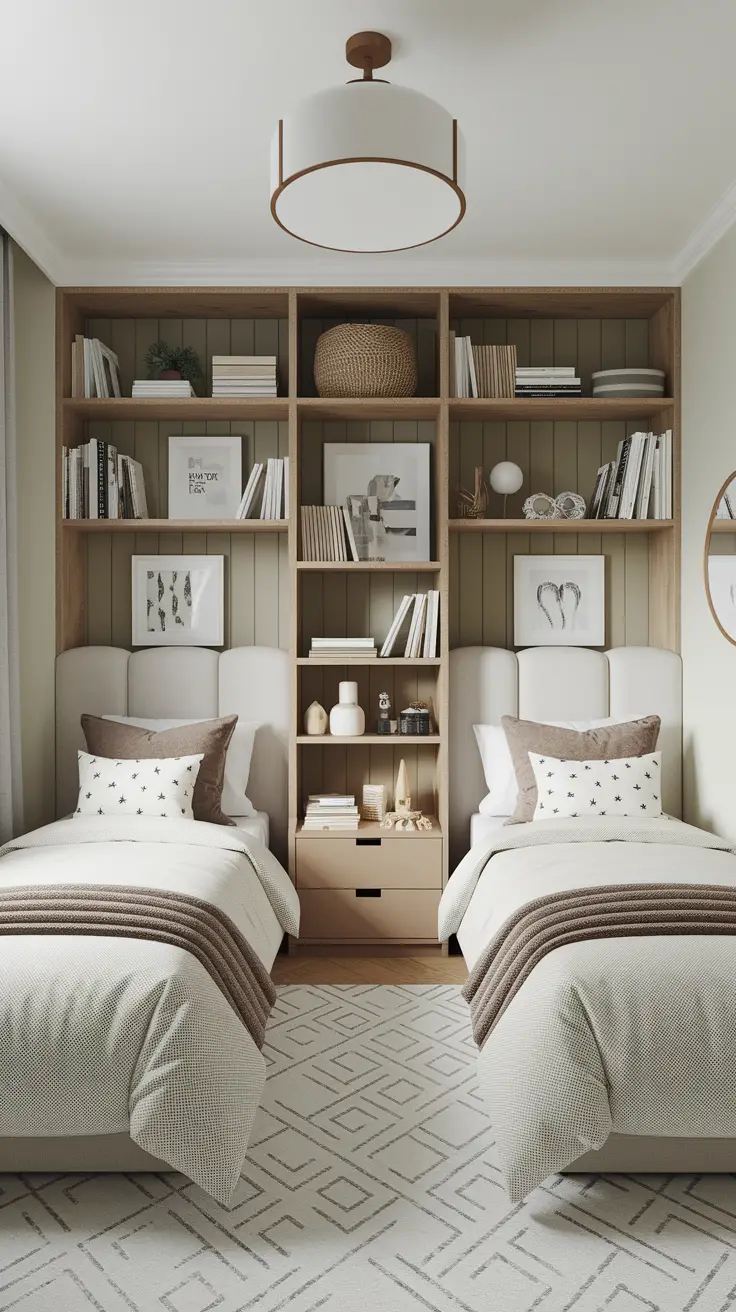
Designing bedrooms for kids can either be overwhelming or a great way to save space for modern families. Two things to consider is how to grant style and privacy for each child. From pairing like colors such as blue and pink to innovative divider ideas, this article explores 27 ways to make shared spaces more organized and maximize personalization.
Kids’ Shared Bedroom: Why It Is A Brilliant Answer For Today’s Families
A shared bedroom for kids is not solely created to save space, it is an avenue for siblings to learn how to live together in harmony. With the shrinking size of homes and increase in lifestyle preferences, modern families are adopting the idea more and more. Today’s shared rooms are not disorganized or untidy; they are strategically decorated to promote peace, self-sufficiency, and imagination. Cozy beds, practical storage, and appealing color schemes adaptable for many ages and numerous personalities are being incorporated by designers. This enables families to stay organized while the children feel like they belong. Understanding their distinct requirements and tailoring a design for both playtime and downtime is the key. Both parents and designers have shifted their focus towards designs that allow for adaptation as the child ages.
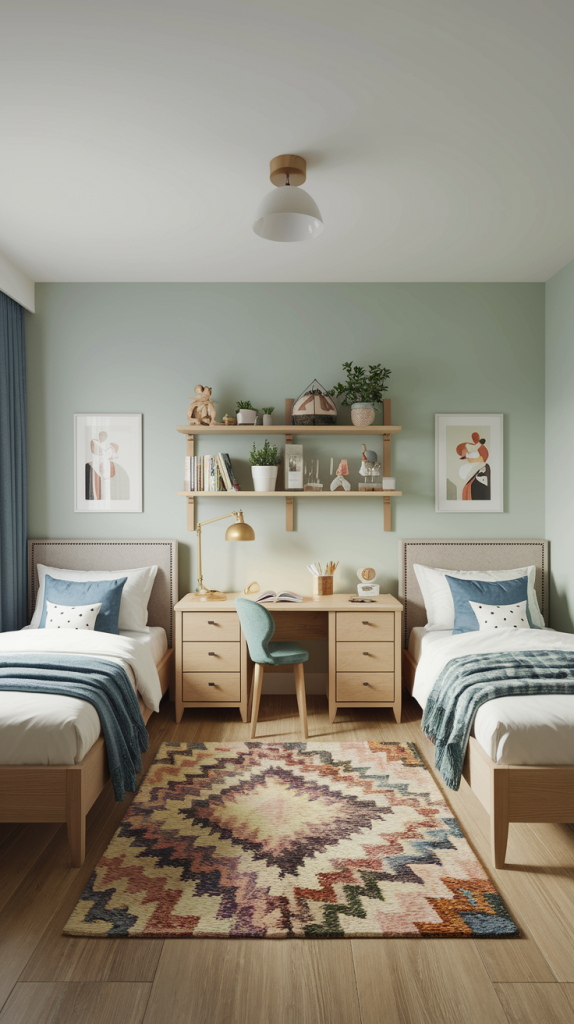
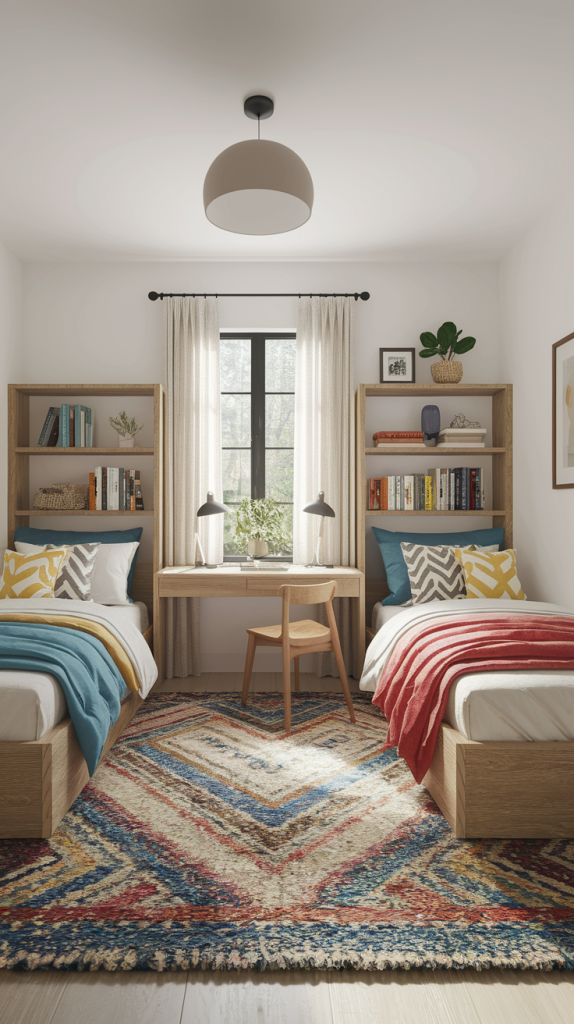
Design tip: Purchase modular furniture and changeable light fixtures to make the room more suitable for the child as they grow older or their needs shift.
Best Shared Bedroom for Kids Ideas in 2025
The newest ideas for kids’ shared bedrooms in 2025 focus on a playful design that is also practical, such as raised bunk beds with desks, wall storage, and zoned play areas. Parents want design solutions that foster interaction among children while keeping the room tidy. The designs include everything from accent walls with chalkboard paint to drawers that are hidden beneath the bed. Soft color palettes with warm neutrals and lively pops of color ensure that the room will remain stylish for years. It is easy to add a personalized touch with decorative name tags, personal shelves, or mismatched bed linens. Cozy but functional lighting, such as dimmable star-shaped night lights, adds atmosphere. Warmth invites creativity and independence while fostering a strong sibling bond.
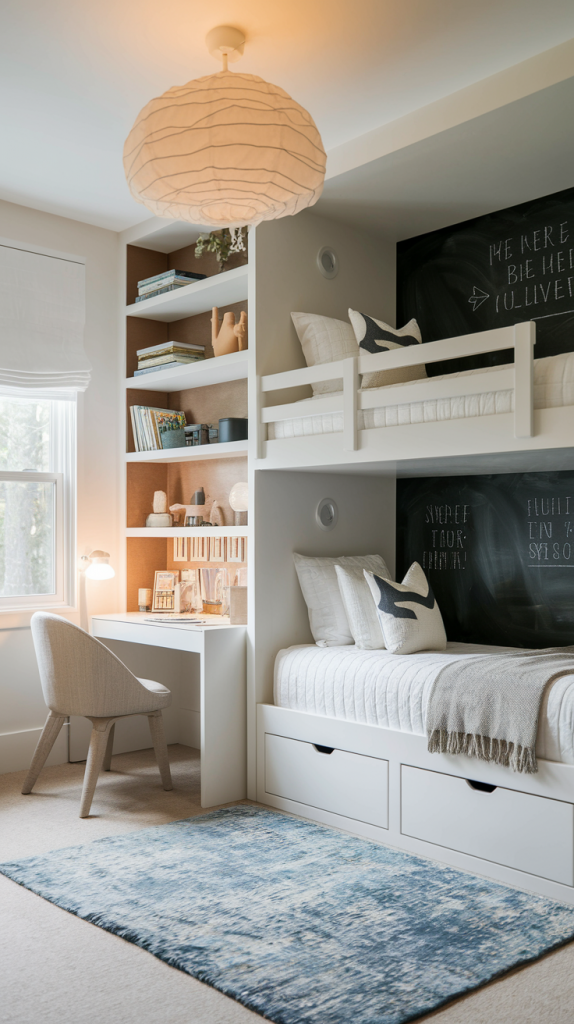
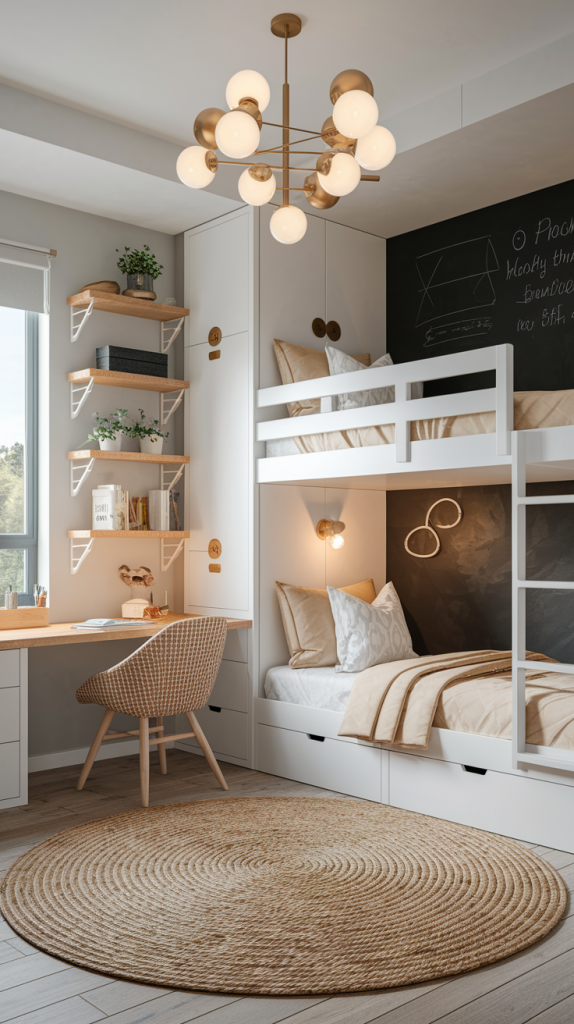
Designer tip: Remember to look up! Vertical space can be utilized with hanging organizers, floating bookshelves, and tall wardrobes.
Effective Strategies to Enhance Privacy in a Shared Children’s Bedroom
Personal privacy in a shared kids’ bedroom becomes increasingly important as they growolder. Although kids may share a room, they require personal spaces which ensures emotional safety. Many kids physically crave boundaries, which can be met by sliding curtains around beds, headboard partitions or even bed canopies. Also, furniture arrangement can create zones, for example, placing beds along opposite walls or back-to-back desks. Personal responsibility can be encouraged through storage such as labeled boxes or bins, which promote fairness as well. If space permits, color accents on each child’s side of the room can subtly indicate ownership. Small details such as personal reading lamps or individual cork boards for bigger children enhance the ownership of space and identity.
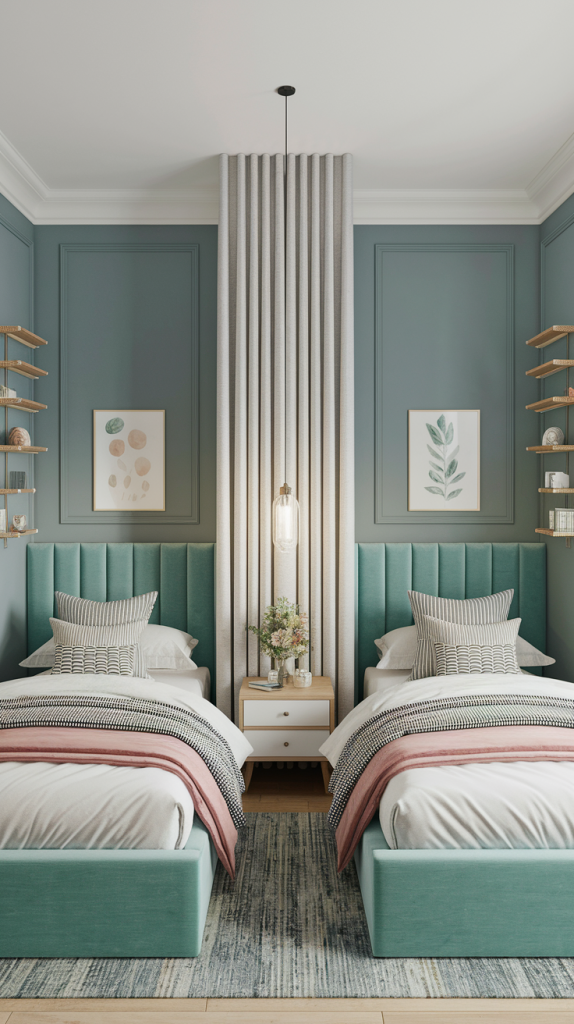

Designers note: Consider using a low open shelving unit as a room divider for a split-space effect while maintaining room openness.
Pink and Blue: Ideal Color Combinations for Sibling Shared Rooms
Using blue and pink is an effective approach for a cross-genre shared children’s bedroom. It brings cool colors like sky blue or dusty navy and warm colors like blush or muted rose together. Instead of splitting the room into halves with each color, a mixture of colors through bedding, art pieces, and accent chairs or tables keeps the design cohesive. Wall murals and wallpaper can blend both hues together in a whimsical way. The walls can be furnished with pink and blue furniture and adorned with white or light wood rugs. Neutral blush and rose accents create a warm feeling when paired with softer lighting and fairy lights. This approach works great for a brother-sister room design.
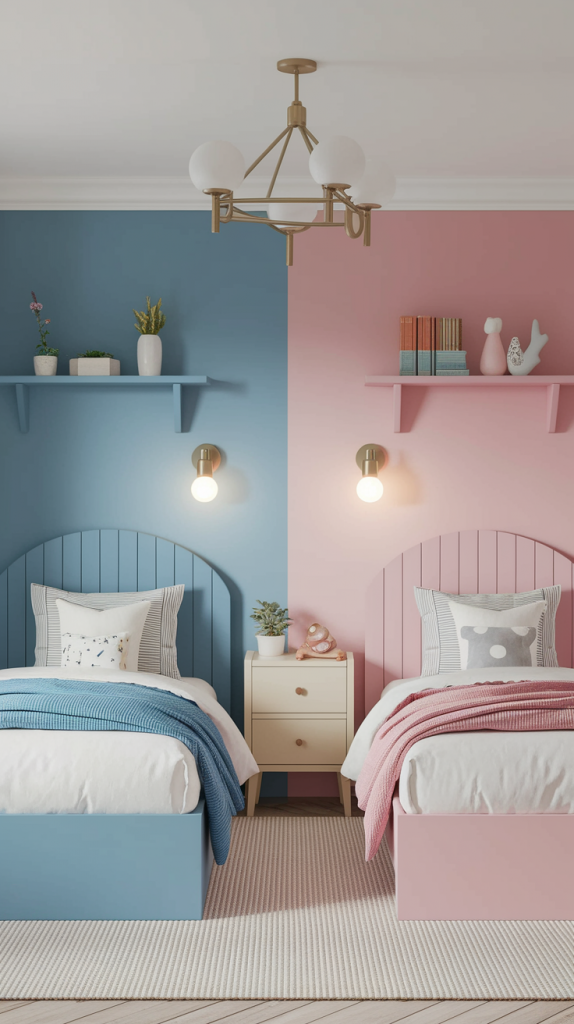

Designer tip: Use neutral colored area rugs and systematic layouts to maintain cohesive themes with a mix of both styles while remaining visually organized.
Ways Parents Can Achieve an Equally Balanced Shared Children’s Bedroom
Both parents and designers face the challenge of balancing style, function, and equity while designing a shared room. An equilibrium bedroom possesses means both children, regardless of their age, interests, or even gender, feel equally represented. Symmetrical arrangements for shared bedrooms tend to work best, such as identical beds on both sides flanking a shared nightstand. Peel-and-stick wall art or storages with personalized name labels are elements that add a touch while allowing for customization without permanent alterations. It is best to start with neutral base tones like gray, sand, or white for the room’s canvas, followed by tailored pops of color for each child. Simplifying the space is key—too many design elements can be overwhelming. Instead, add cohesive touches like matching headboards or pendant lighting that connect one side of the room to the other.


Designer tip: Foresight is key when selecting furniture for different stages of childhood; opt for adaptable furniture.
Strategies That Work on a Brother and Sister Sharing a Room
When it comes to designing a shared room for a brother and sister, the challenge can seem more complicated, but it is resolved in a combination of styling and design techniques. Look for features that can serve as the foundation for a base to neutral theme such as animals, space, or nature. Color zoning should be used, one side can have green and gray while the other is lavender and beige. Central rugs and bookshelves create shared spaces, while personal touches like wall decor and lamps express individuality. Try using symmetrical furniture arrangement, and flexible products such as beds with drawers or desks that are easily height adjusted. Warmth can come from combining various materials, such as soft bedding, wood finishes, and cotton curtains.


Designer tip: steer clear of harsh gendered decor and instead work to establish cohesion with balanced colors and patterns.
How To Divide A Room Without Renovating: Smart Use of Space
Clever splitting can be done without requiring a full remodel. Rotating parallel beds so that they face opposite walls automatically creates zones. Tall bookshelves or a shared dresser can serve as a more open natural divider while still allowing light to flow through. Deciding which walls or corners for children’s styles can be placed for them to freely personalize their sides. Rugs can also help define zones to further separate spaces. For more flexibility without design restrictions, mounted desks or lofted beds open up floor area too. Small table lamps or dimmable sconces easily control the child’s area and allow them zone setting to turn on the lighting.

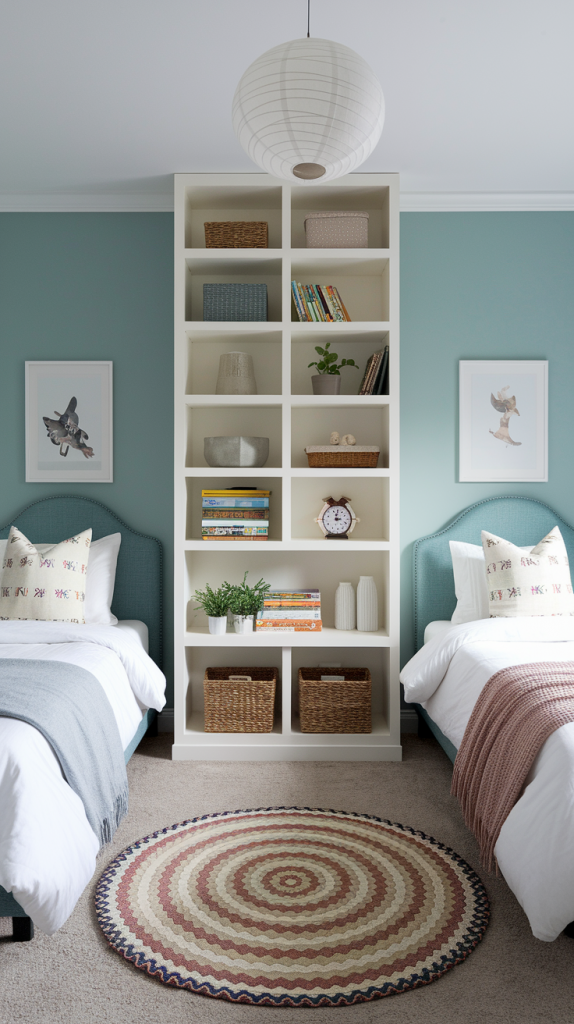
Designer tip: for changing children and evolving demands, easy rearrangement supported by provide reversible layouts work best.
Unisex Shared Bedroom Ideas That Balance Equality
A unisex shared bedroom for children upholds equality, enjoyment, and adaptability without heavy reliance on gendered themes or colors. Consider earthy hues of sage green, clay, ivoy, and warm wood blended with playful patterns such as stripes, stars, or abstract shapes. Symmetrical arrangement of furniture supports equality while shared reading nooks or cubby storage encourages collaboration. Add personalized touches like mmonogrammed pillows or custom bedside art to help each child feel acknowledged. Avoid stereotypes and strive to foster an environment that inspires curiosity, creativity, and comfort. Use gentle lighting and timeless furnishings to make sure the space ages well over time.


Designer hint: Balance bold accents of mustard, teal, or terracotta to liven up the space in a more gender-neutral direction.
Room Ideas for Boys Sharing a Bedroom with Siblings
With siblings, boys usually have to share a bedroom, so when designing the space, consider both enjoyment and practicality. Consider an exciting yet flexible design such as sports, space, or jungle animals. Use long-lasting metal furniture such as bed frames, cube shelving, and mounted lights. Navy blue, forest green, or burnt orange walls contrast beautifully with light wood tones. Use bedding and wall decals that themed to match the boy’s personality, like sports, but ensure it still goes with the room. Designate an area for them to play together that also allows them to study concurrently.


Designer Tip: Embrace strong colors; just be ready to balance them with light and natural materials to keep the room from feeling claustrophobic.
Creative Decor Ideas for a Stylish Combined Bedroom
An elementary school shared kids’ bedroom can be turned into a stylish and practical children’s sanctuary with the help of clever decorating ideas. Each child can have a mini gallery where their personal art or favorite pictures are displayed. Headboards, lamps, and even bedding can be color coordinated to match which unifies the room. Washi tape or wall decals can be used to add non-permanent accents that can be changed at any time. String lights, bold fabric throw pillows, and adorned fabric bins can all add to a carefree atmosphere that makes the space feel cozy and fun. Name signs and decorative name pegs can add personality without overpowering the shared space. Make nature branch with plant prints or include rattan for a soothing yet trendy vibe. Allowing children to help decorate instills a sense of pride and ownership toward the space.
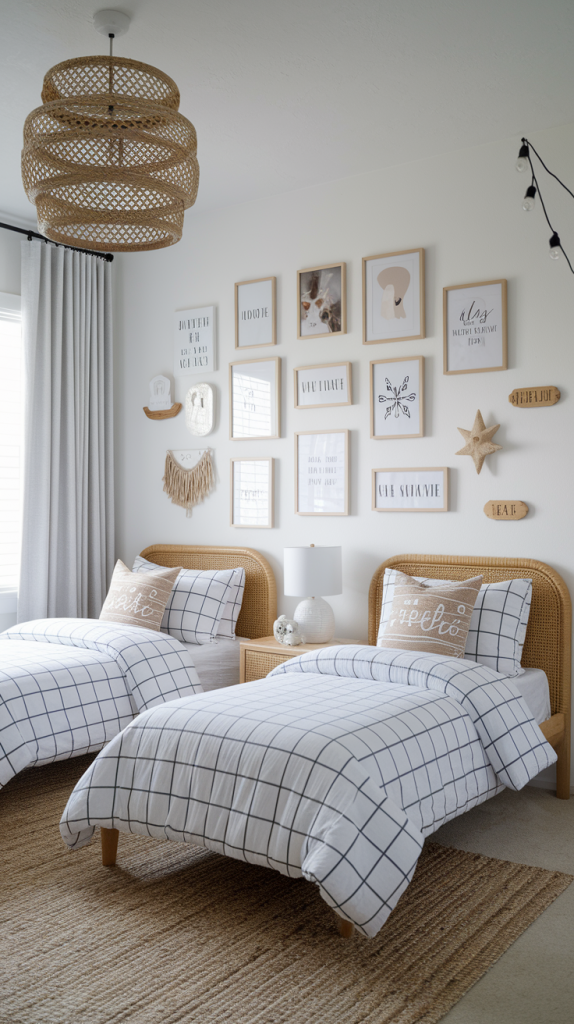

Designer advice: Avoid overcrowding the space and remember not to add too much decor. This allows for negative space on the walls and floors which adds an effortlessly flexible and breathable feel to the room.
Small Shared Bedroom Layouts That Feel Spacious
Designing a small room to be shared by two people can be challenging, but with spatial mapping, it won’t have to be clunky or inefficient. Try to pay attention to furniture that performs more than one task, like storage-integrated bunk beds, mounted desks, and vertical cabinets. The room’s primary colors should be light and soft so as to visually increase the room’s size; consider adding mirrors to capture and reflect sunlight, enhancing the illusion of depth. Another way to accentuate depth perception is through clever vertical storage options like cubby shelves and suspended tiered shelving. To conserve room, favor curtains or sliding doors over hinged doors. Place rugs in the layout to demarcate zones tailored for the individual children, lending a sense of stability to the space. Uniformed pillows and small accent pillows themed around a central idea can serve as themed decorations to be the finishing touch on the room.
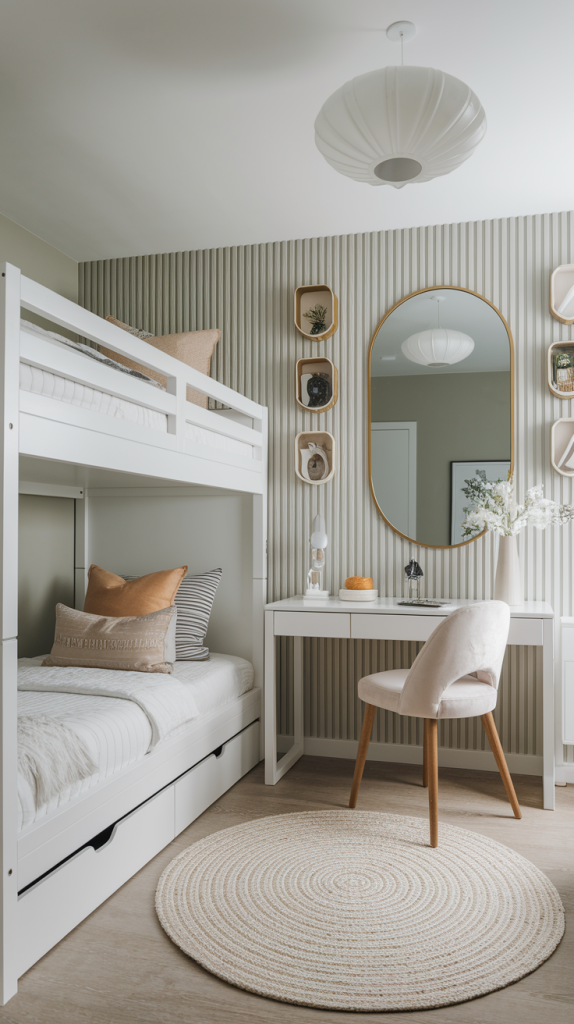

Designer tip: Pick furnishings that have no fabric at the bottom like a chaise lounge chair with exposed legs to have an open feeling and visually increase the room’s height.
Small Room Solutions for Two Kids
Balancing space and motherly love can be tough when you have to accommodate two children. Place beds in the shape of an ‘L’ so it occupies the corners and arranges them to free the center of the room. Utilize bins that can be stacked, wall hooks, and messy areas for wasted space under the beds. Choose furniture such as night stands that convert into work desks or storage benches meant to be used as seating for the night. To make sure there is no eye straining crowding of surfaces, use wall lamps. Try to avoid visual clutter by keeping the color palette and patterns simple. Creativity and collaboration can go hand-in-hand on the shared cork board or dry erase wall.
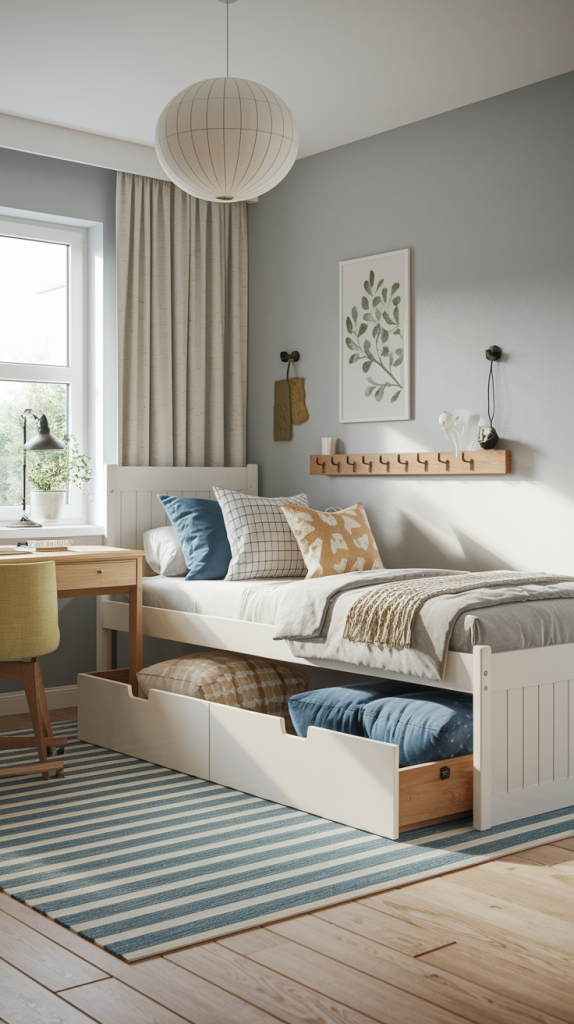

Designer Tip: When working with children’s rooms, bulky furniture is a design no-go. Choose slim-profile pieces that still provide function without overwhelming the room.
Room for 2 Beds: Optimizing Available Space
When balancing form and function, symmetrical arrangements are the most rational approach. Place two identical beds parallel to one another with a matching nightstand or small table in the middle. Use coordinating blankets and lamps to create a cohesive design while allowing personal touch with wall art or decorative pillows. Alternatively, beds can be staggered or T-shaped to accommodate difficult room configurations. Headboards with storage incorporated, or wall-mounted shelves above the beds, can help reduce clutter on the floor. Where appropriate, a central rug can anchor the area and provide cohesion. The color scheme to be kept light and fresh, complemented by vibrant hues for personality.
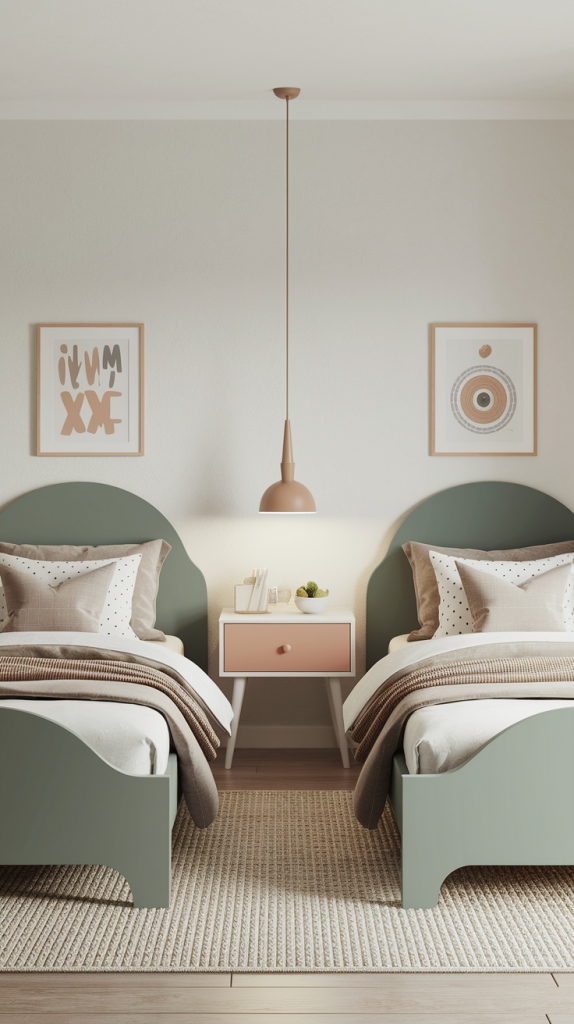

Designer tip: For an added dimension, if beds are placed against opposing walls add rugs or light runners beside each bed to cozy up the pathways.
Working Ideas For Shared Baby and Toddler Rooms That You Might Find Useful
The combination of a newborn and toddler in one shared room may seem complicated, but with the right room design, it can be done effortlessly. To achieve symmetry, visually appealing cribs and toddler beds can be merged into one space. Ensuring the color scheme is gentle such as the white, light grey, and hints of pastel promote relaxation as well as uniformity. A shared dresser with distinct markers on each side aids in organizing clothing and other supplies. With different napping schedules, gentle lights and blackout curtains help as well. Use decor that is sweet but not overly specific in age to allow the room to adapt with both children. Mounted bookshelves or a communal reading space fosters bonding from an early age.

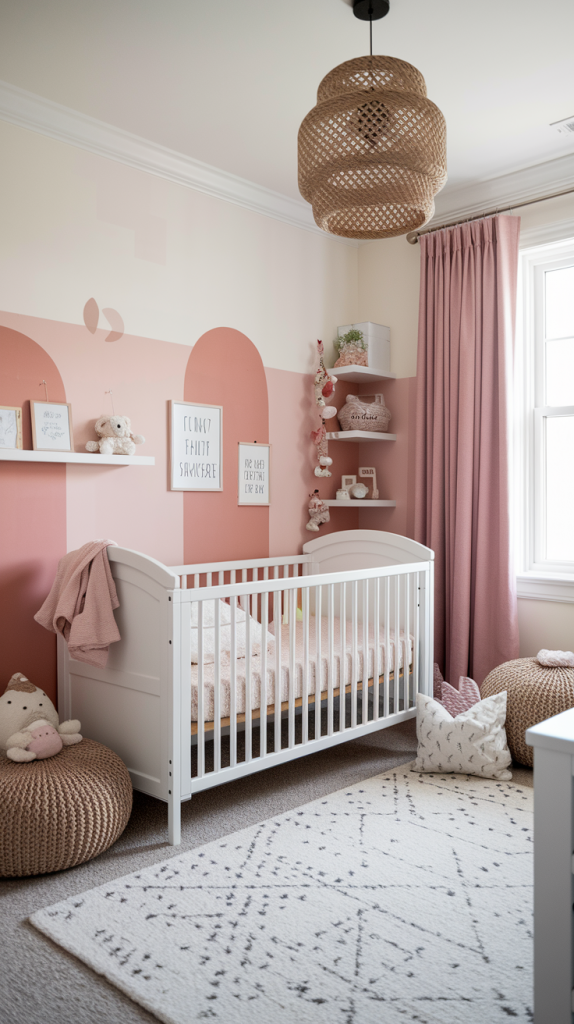
Professional tip: Use a noise machines or pillows to lessen the impacts of disturbances for the child that has not yet woken up when one child wakes up.
Tips on Shared Bedroom Decorating While Keeping It Cohesive
The most creative challenge in a shared kids bedroom is allowing for individual expression while keeping the space aesthetically balanced. You can start off with color schemes that express each child’s personality through art, bedding, or lamps. Use symmetry to your advantage. Similar beds, matching curtains, equitable shelving, and even organizational systems create a cohesive flow. Soft textures like rugs and throws, along with upholstered headboards will maintain a warm atmosphere within the room. Make labeled storage bins or drawers so that each child knows their designated space. Incorporate overlapping decor—stars, animals, or geometric prints are greats themes that will express their individuality while keeping the room cohesive. Invite them to contribute to the accessories so they feel a sense of ownership.
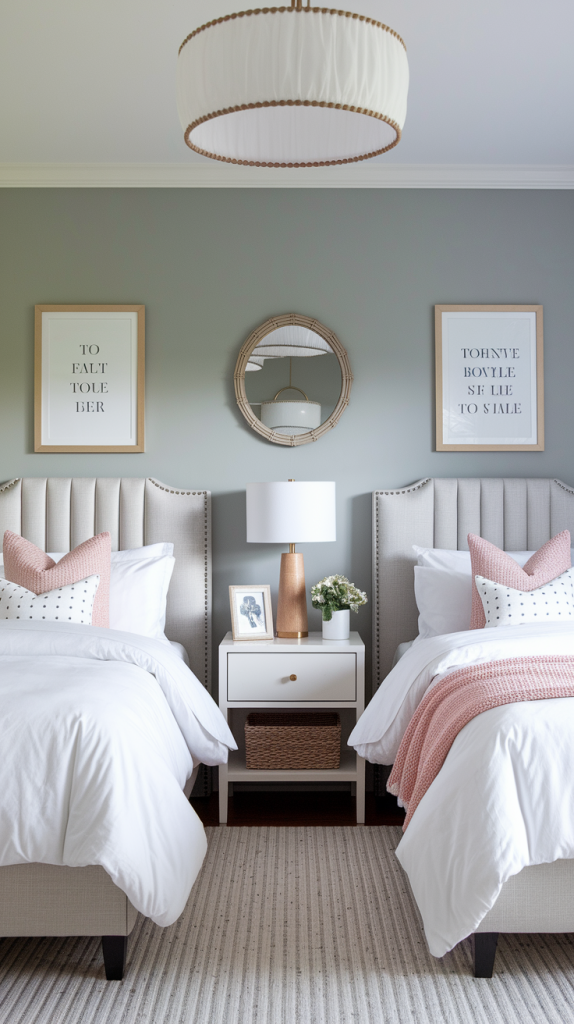
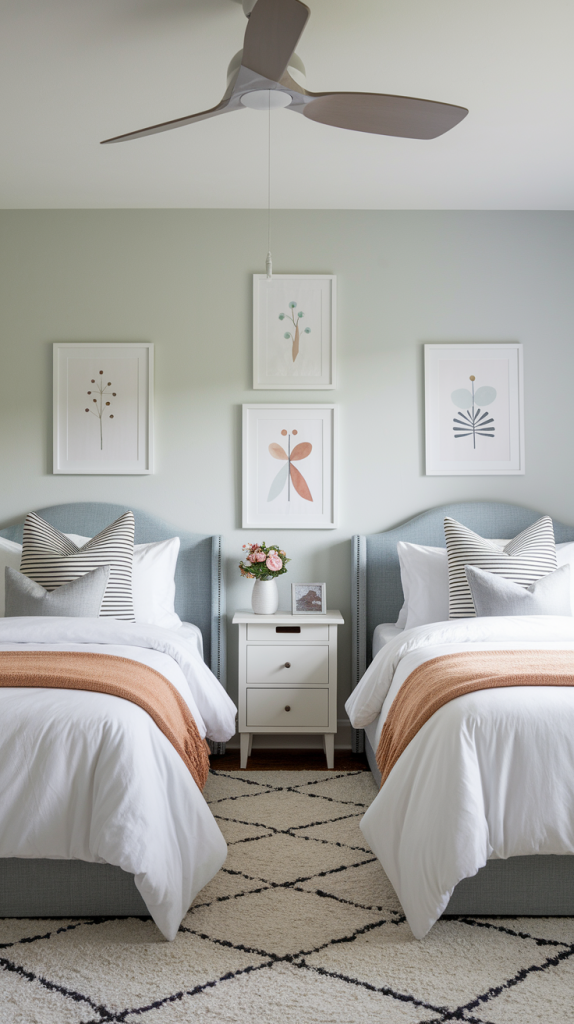
Designer tip: Walls should remain light and flexible so that color is added through accessories which are easy to swap out.
Ideas to Divide Rooms for Creating Boundary Lines
Proper room divider ideas can provide instant visual privacy alongside structure within a shared bedroom for children. Rollable room dividers made of lightweight materials are excellent temporary solutions that leave most of the room visible while still providing each child their own area. Sliding panels or foldable screens are also used in rooms where flexibility is a must. For smaller children, curtains suspended from ceiling tracks provide a great deal of enclosure without making the floor area feel cramped. Opt for dividers that incorporate storage or display space. Ensure the divider blends with the color scheme of the room and does not dominate the room visually. Precise placement of lights or carpets on either side enhances the sense of demarcation.
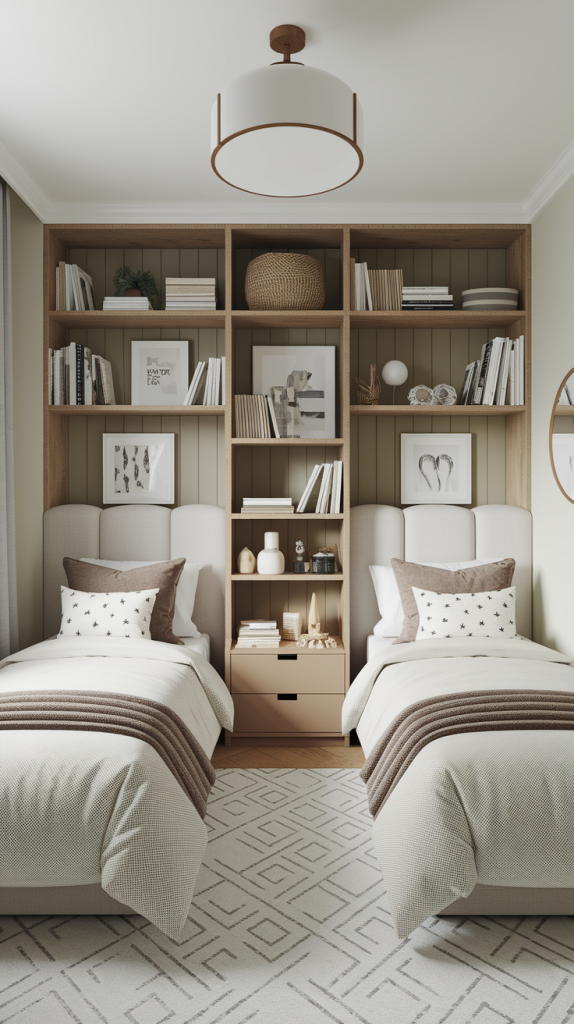

Designer’s Tip: Try not to go too tall — dividers that cap off light flowing over or through them will keep the room feeling bright and spacious.
Split the Room by Task: Sleep, Study, Play
One of the most effective strategies to organizing shared bedrooms for young children is function-based zoning—sleep, study, and play. For instance, position a bunk bed or two twin beds along one wall to create a sleeping zone. Set up a homework area with two small desks and a shelf along a separate wall to maximize ease of access to tools and supplies. The play region can be a tucked away, low-traffic area equipped with soft rugs and toy bins, along with flexible seating like bean bag chairs. Use lamps to define purpose: study lamps for desk work, soft lamps for bedtime, and ceiling lights for area play. Distinguishable visual cues like wall stickers, rugs, or artwork can help define each zone which is essential for small, shared spaces.
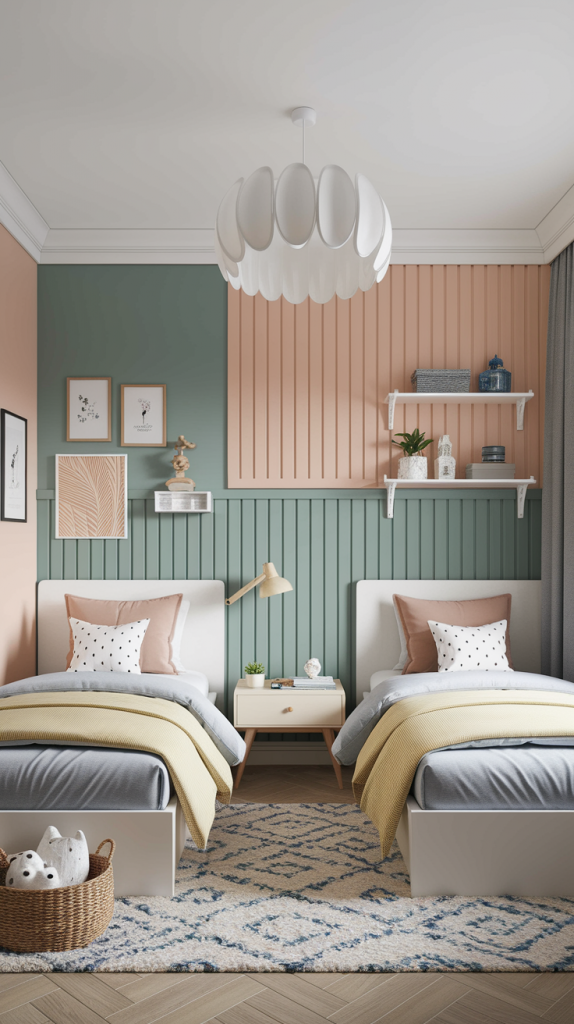
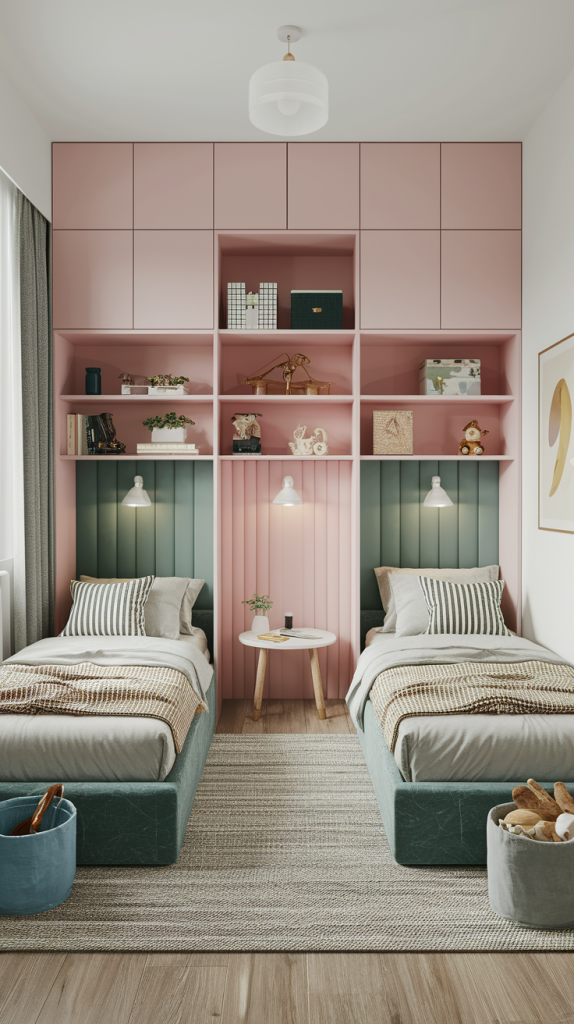
Designer tip: Subtly reinforce borders with color for each zone, such as utilizing a blue rug for study, neutral for sleep, and yellow for play.
Shared Bedroom Storage Solutions That Hit the Spot
To make shared spaces more efficient in a children’s shared bedroom, effective storage is a must. By using cubes on the walls and organizers in the closets, vertical space can also be utilized. Shared dressers with labeled drawers facilitate fairness and help avoid disagreements. Store bags, robes, and hats on hooks attached to the back of doors and bedframes. As children grow, fabric bins, rolling carts, and other modular units simplify adaptive storage. Add some excitement by color-coding each child’s storage: one has blue while the other has green, for example. Granting children the opportunity to organize their spaces fosters a sense of ownership.
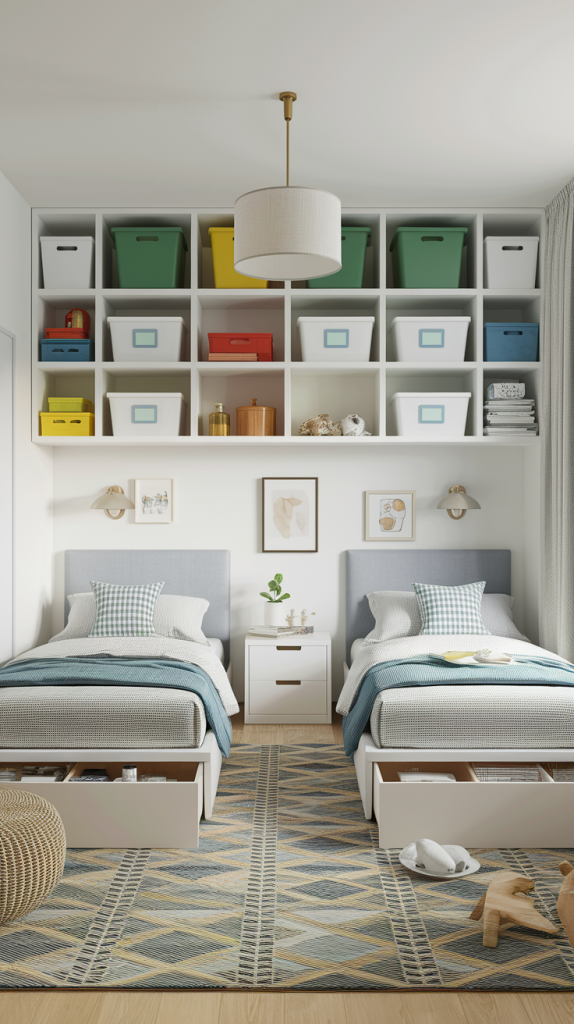
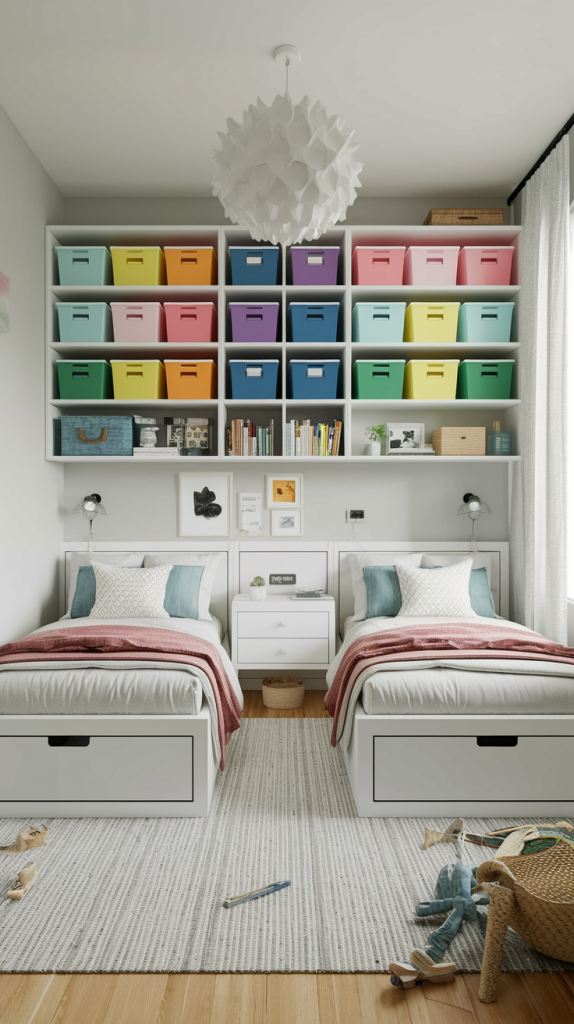
Designer’s tip: Keep away from oversized pieces—furniture that can be stacked or arranged offers adaptable storage for growing kids and flexible needs.
Balancing Different Sleep Schedules in Shared Children’s Bedrooms
Balancing diverse sleep times for children sharing a room can be difficult, but room design helps. Use blackout curtains or separate bed canopies for one child to sleep uninterrupted. Blockers like sound machines or soft ambient sound help reduce distractions. Strategically position the beds, for example in a head-to-foot arrangement, to minimize waking each other. Each nightstand can have dimmable lights which allow one child to read while the other rests. Nighttime routines can be subtly customized with individual decor items like storage baskets, calming lamps, or soothing decor. This scenario empowers children as the environment is shared to some extent, but actively controlled.


Designer Insight: Toddlers can be encouraged to rest longer with low enclosed beds or curtains transforming beds into “sleep pods.”
Finding a Balance Between Individual vs. Collective Style in a Shared Children’s Bedroom
Strike a balance when it comes to individual vs. shared elements of decor in a children’s room and try to find a middle ground. You can create harmony by having the same bedside rugs, bedspreads, and curtains, while allowing each child to voice their individuality through posters and wall art. Begin with a white wall or wooden furniture set as the base and personalize them through adornments. Each child can select decorative features for their respective sides but try to maintain uniformity in the overall design. This way intact personalization and custom touches to each region will shift design ownership while preserving unity throughout the entire shared space. Name signs or blocks of colors on the walls are amazing ways to designate each child’s zone without overwhelming the space. Comfort and a sense of ownership over shared belongings is what you should be striving for.


Designer tip: Reserve sophisticated elements and let children run loose with smaller furnishings whilst maintaining a calm aesthetic.
Bunk Beds or Twin Beds? Which One Works Best?
Choosing between twin beds or bunk beds is often the first challenge faced when designing children’s shared bedrooms. Bunk beds work best in smaller shared spaces where maximizing the vertical area is important—this leaves more area in the room for either play or study zones. Twin beds provide easier access for younger children, as well as customizable layouts things like headboards and decorations. Keep in mind elevation of the ceiling, age gaps of the siblings, and how they sleep. Vertical storage cubbies with built-in shelves and stairs instead of a ladder offer safety and storage. For larger rooms, twin beds arranged in an L-shape or on opposing walls define personal spaces. Coordinated decor can still unify the room regardless of bed choice.
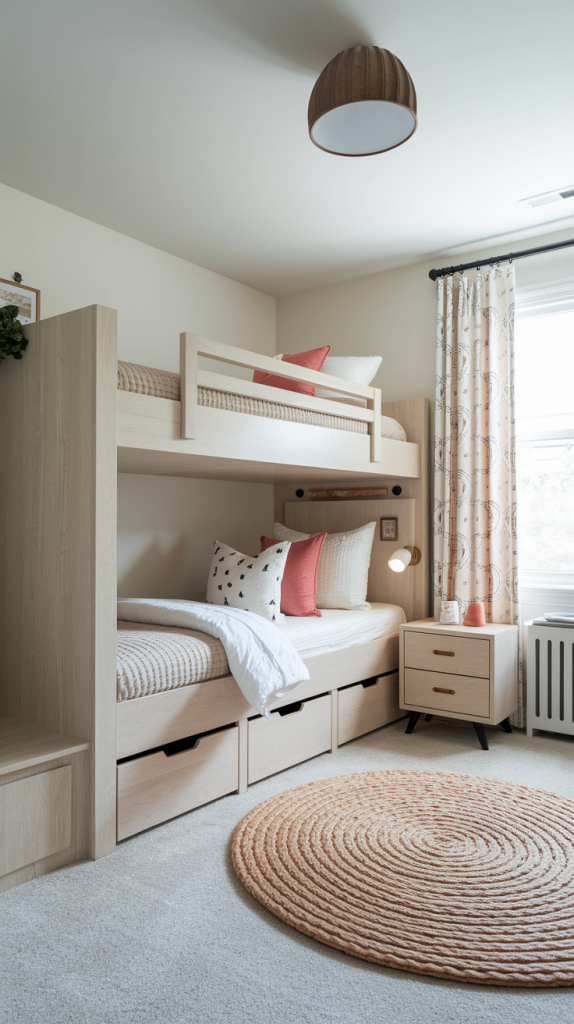
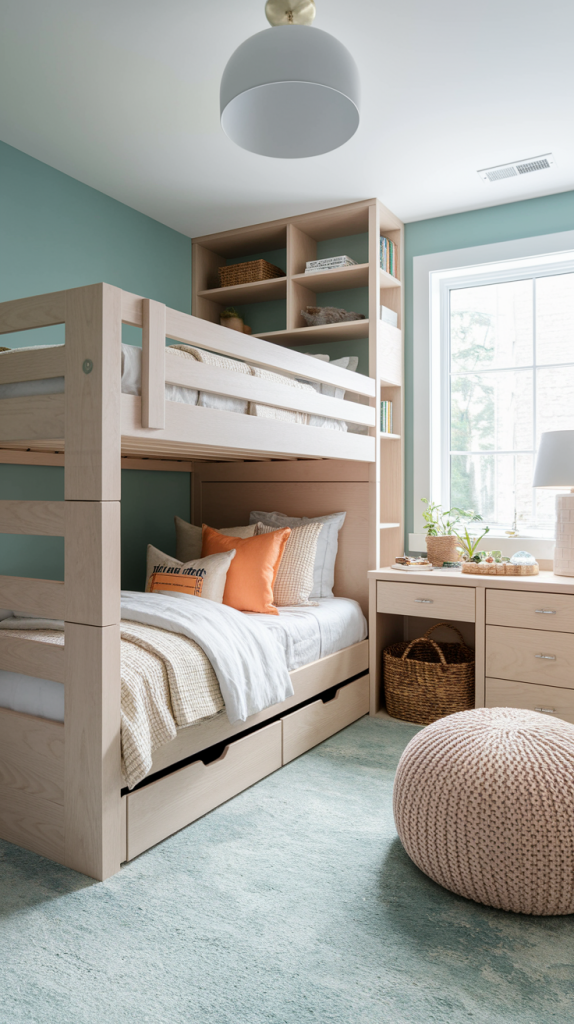
Interior design insight: For those still pondering on this, modular bunk beds that convert into twin beds provide a growing solution.
Safety Considerations When Planning A Shared Bedroom for Small Children
When it comes to shared rooms, safety is most important for younger siblings. Use low beds and anchored tall dressers, and avoid loose belts and hanging cords. Non-slip mats enhance cushioning for falls and soft floors, and safe climbing opportunities help control risks. If you decide to have bunk beds, they need to have securely fitted guardrails, stairs, and secure steps. Shared floor storage must be easily accessible to avoid risk from climbing. Non-toxic safety paint cushions and pathogenic finishes creates nurturing surroundings.
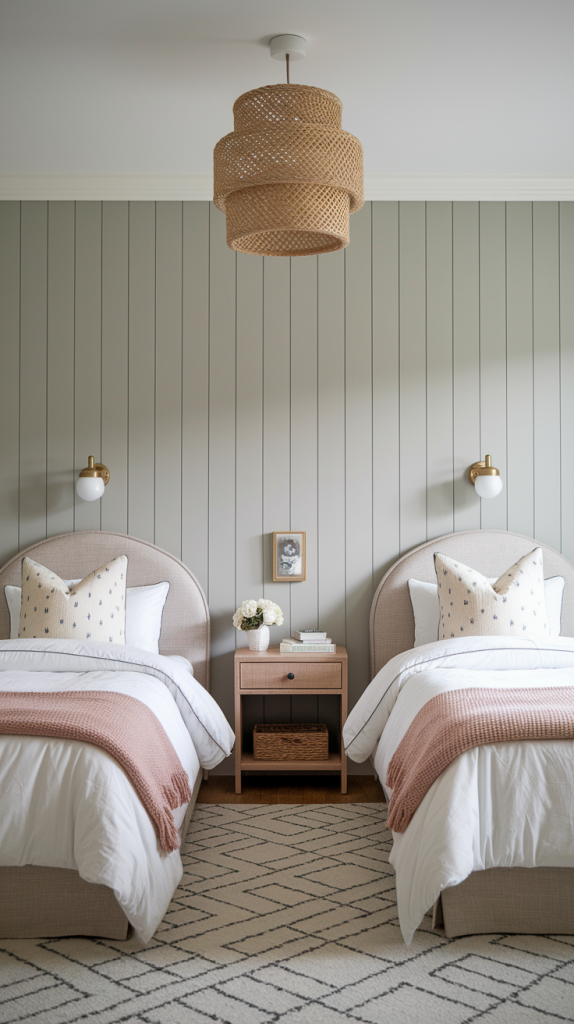
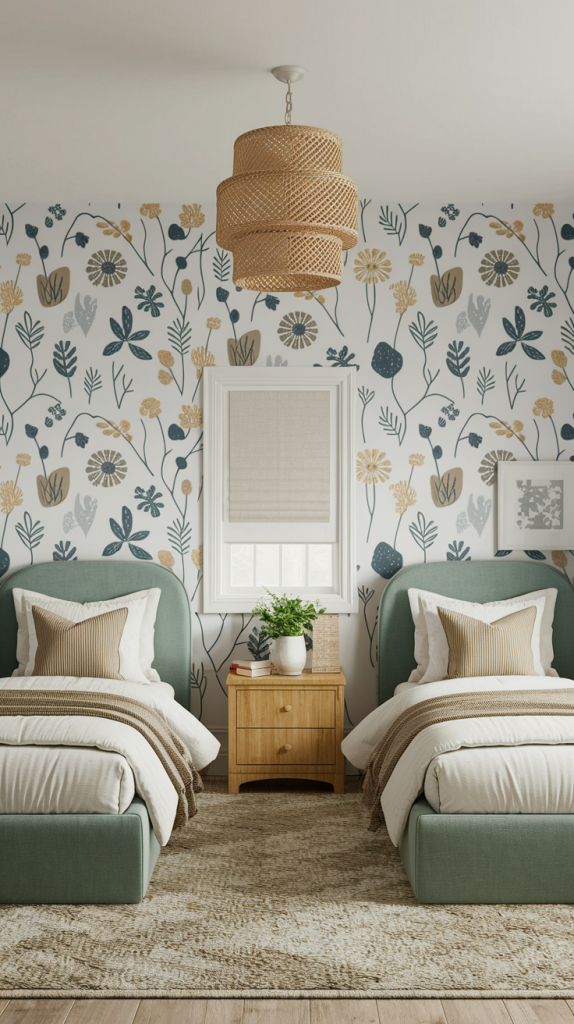
Designer tips: Adding nightlights with motion sensors and soft closing drawers prevents fumbles do during the night.
Unique Themes for Shared Kid’s Room that are Amazing
With a bit of creativity, you can turn a shared bedroom for kids into a cozy getaway by the use of imaginative themes. Theme ideas that are likely to be popular in 2025 include outer space, enchanted forest, jungle safari, or under-the-sea adventures. Start by picking one color that will work for both kids, then add themed elements like pillows, bedding, and wallpaper murals. Use more subtle prints for decals and art so that it can be appreciated at different ages. Each child’s drawings or a shared themed reading nook can serve to inspire in the themed context. Make sure big furniture pieces like a closet or desk are in neutral colors and use them to frame the room so that the small accessories can add the fun. When it comes to balance, less is more; don’t overpower the theme too much.
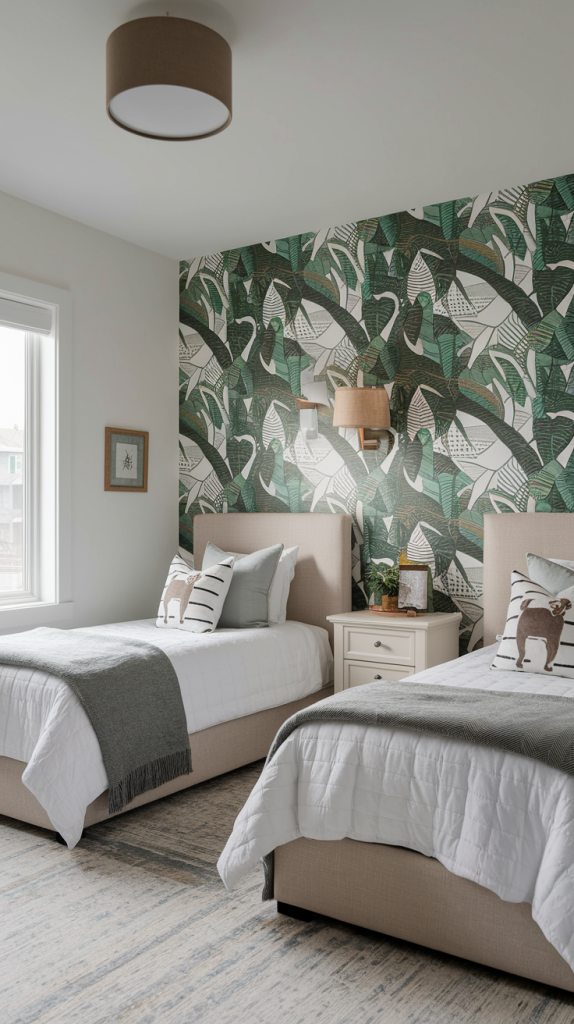
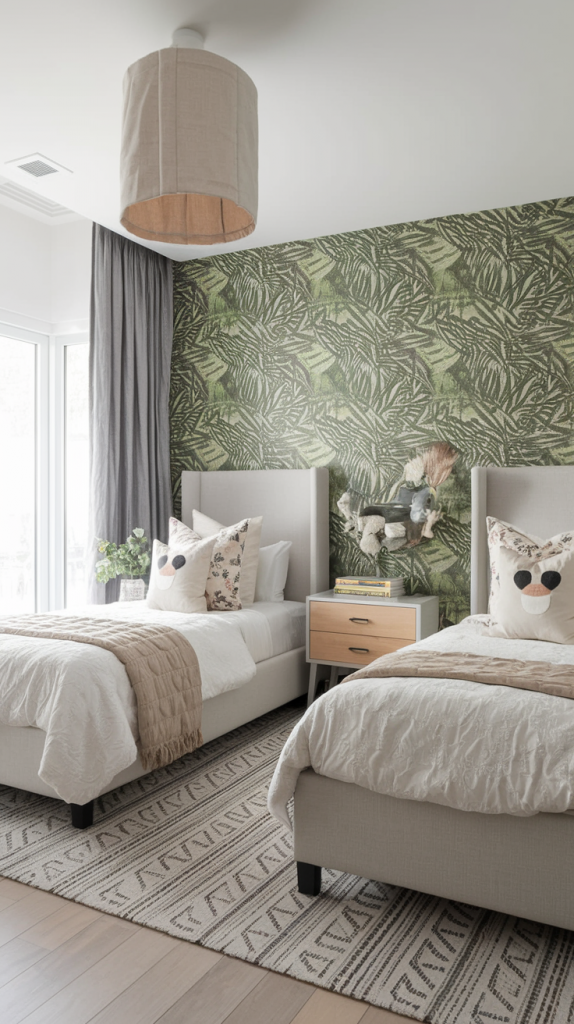
Designer Tip: Allow the kids to have a vote on the theme. It creates a sense of excitement and collective ownership.
How to Allow Each Kid to Showcase Their Individuality in One Room
Maintaining individuality in a shared room can be as easy as providing light partitioned areas of expression. Let every child select their own comforter, some wall art, or a tiny shelf where their memorabilia can be displayed. Definitely manipulate color; both sides of the room may have different but complementary accent colors while sharing a base palette. Custom monogrammed items and personal bulletin board s add a unique flair. Create cohesive design through soft furnishings such as curtains, rugs, and cushions so that no disruption is felt.


Moreover, permit children to seasonally or thematically decorate their sides for the time on a frequent basis. Making choices for them builds confidence and a sense of ownership.
How to Make a Shared Room Work Long-Term: Things to Think About
Making a kids’ shared bedroom sustainable through their developmental stages requires flexibility on every design decision. Opt for furniture pieces that can be adjusted based on age such as balance desks, extendable beds, and modular storage. Keep major furniture pieces and walls decor neutral to allow the rest of the room to adapt to changing interests through time. Make the room adaptable for layered lighting as well—add overhead, task, and nighttime lights for varying routines. Purchase quality storage furnishings that are changeable and can be remodeled to adapt to a child’s changing needs over time. Pause and think about the future: will this later be a study room or chill space for a teen? Consider all these things when planning the layout as well. Make sure to design the floor plan with the possibility of open carpet areas for changing stages of learning and play.
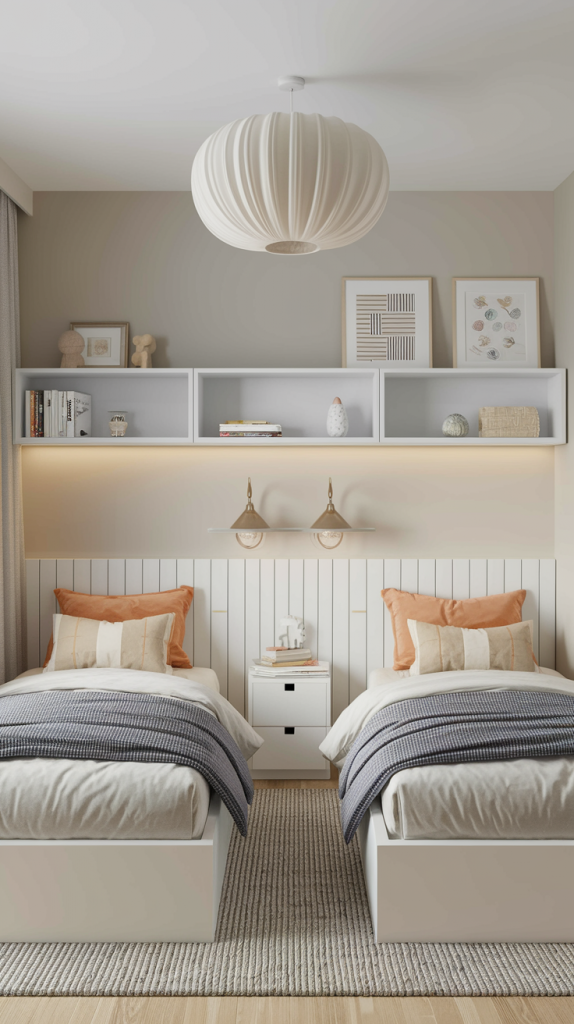
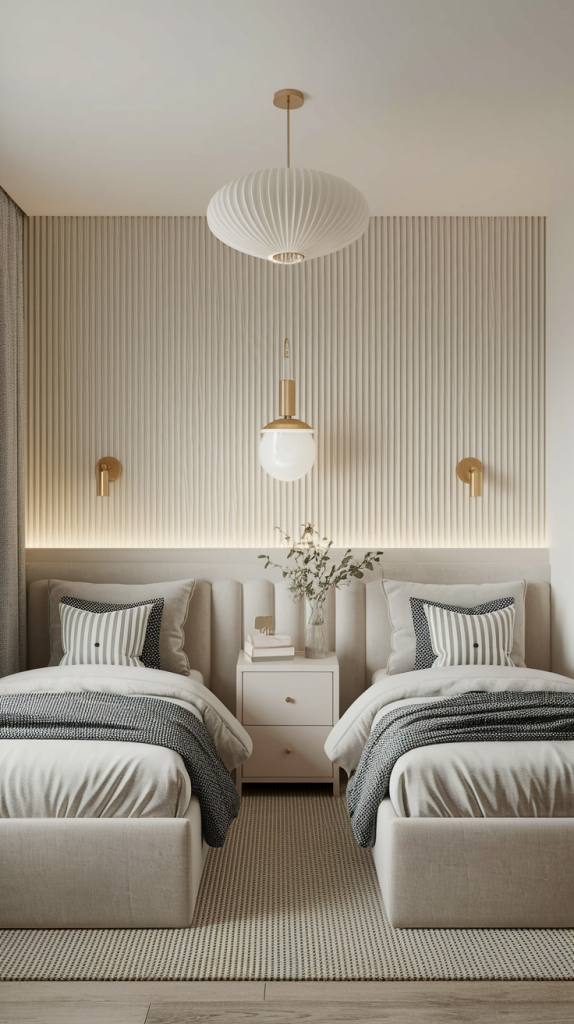
Designer tip: Get ahead of the curve and think about how the design will need to be reallocated in the future to create cost effective and natural looking changes.
Cost-Efficient Shared Bedroom Revamp Suggestions
Revamping a shared kids’ bedroom need not be costly. Start by painting the room. A neutral base with an accent stripe or mural adds charm. Existing furniture can be updated with child-friendly paint, or covered with removable wallpaper. Fresh textiles like colorful vibrate bedding or warm throws help elevate the room’s energy. Add humor and attitude without strong commitment using posters, wall decals, or print art. Storage for boxes and bins also alter the aesthetic. Labeled crates also give the transformation some sophistication. Any secondhand or thrifted items like desks or nightstands can be refinished to had the value add.


Designer tip: While overbuying easily alters a space, simplicity in themes enhances it. Limit yourself to 2-3 specified colors that alongside key shapes and details create not clutter, but well-ordered elegance.
Dual Purpose and Enjoyable Shared Bedroom
The most creative shared bedrooms for kids blend function and whimsy seamlessly. Select beds with drawers, multifunctional desks, and adaptable poufs or beanbags used for seating. Liven up the area with colorful throw pillows, humorous wall decorations, and fun features, such as reading tents or walls made of chalkboard paint. Use open shelving to organize and display cherished toys and books to reduce clutter on the floor. Create a fun color combination: energetic but not too harsh shades like turquoise, mustard, or coral work well. Sprinkling soft fairy lights alongside ambient lighting brings that special touch. A warm reading corner, or a combined inventing area, encourages cooperative imaginative play.

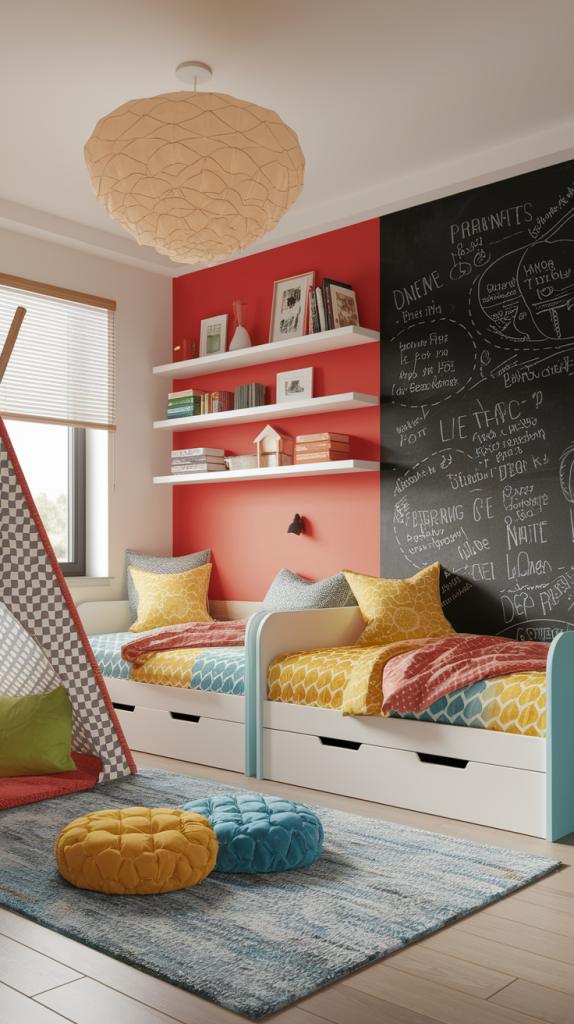
Designer tip: Incorporate a small bulletin board or picture space so that kids can personalize their spaces as they grow.
Conclusion
Creating a shared bedroom for children is not only optimizing space but rather faciliting a supportive and multi-dimensional environment that helps siblings nurture their bond together. All elements from clever layouts and personalized zones to practical storage and playful themes encourage harmony and individuality. The endless possibilities whether dealing with shared small rooms, boy-girl sibling dynamics, or looking for creative room divider suggestions, with some creativity there is always a solution. Any favorite tips or design questions regarding your children’s shared space? Leave your insights in the comments, we are all ears!
